- Action spectrum of the respective effect (UVB, UVA, UV-Index, Vitamin D …): $W(\lambda)$, without a unit, unsually normalized to $\mathrm{max}(W(\lambda))=1$)
- Spectral sensitivity of the meter: $A(\lambda)$, without a unit, unsually normalized to $\mathrm{max}(A(\lambda))=1$)
- Spectral irradiance of the light source: $E_\lambda(\lambda)$, unit µW/cm²/nm
- Spectral irradiance of the calibration lamp: $E^\mathrm{Kalibr.}_\lambda(\lambda)$, unit µW/cm²/nm
- Correction factor: $a$
- Calibration factor: $K$
Table of Contents
uv
UV Broadband Meters
Broadband meters are among the most used UV meters, as they can be purchased at an affordable price (starting from about 150€). They stand out due to the high reproducibility of the measured values, a high signal to noise ratio, and very easy handling.
All the advantages of broadband meters over spectrometers make them popular for reptile keepers. The interpretation of the measured values is, however, comparably complicated: Broadband meters measure the irradiance weighted with their own sensitivity spectrum, which do not agree with the correspondent name of the broadband meter. Measured values of different lamps or different brodband meters are fundamentally not comparable. Especially a lamp with a lower measured value at one braodband meter can nevertheless have higher physical uvb irradiance or a higher ability to facilitate vitamin D production.
Without knowledge of
- the spectrum of the light source
- the sensitivity spectrum of the broadband meter
- the calibration of the broadband meter
- the spectrum of biological process of interest
the informative value of a broadband meter is quite limited.
Construction and Function of a Broadbandmeter
Notes regarding nomenclature1)
Photodiode
The basis of a braodbandmeter (radiometer) is a semiconductor photodiode. The current through this photodiode changes when a photon (light particle) is absorbed by the semiconductor. But a photodiode does not react to every photon equally! The energy or wavelength of the light has to match the “band gap” of the semiconductor. For visible light usually silicon is used, for the uv range SiC, GaN, diamond or GaAsP are needed. The response of the photodiode can be further constricted by a filter that stops radiation that one does not want to measure.
In photoconductive mode the electric current dependes linearly on the number of photons. Therefore, Photodiodes are a good device to measure the irradiance of a light source.
In the end the properties of a broadbandmeter is contained in its spectral sensitivity curve $A(\lambda)$.
This sensitivity curve, together with the spectrum of the light source, determines the signal of the broadbandmeter: A lamp with 10µW/cm² in the range between 280nm and 290nm and nowhere else with give the same signal as a lamp with 20µW/cm² in the range of 305nm to 315nm, because the sensitivity of the meter is only 50% at 310nm. On the other hand, the same intensity of uv light (10µW/cm²) at 285nm and 310nm will not give the same signal. The signal at 310nm is only 50% of the signal at 285nm.
This behaviour is expressed in the mathematical formula. The current signal of a photodiode is \[ S = \int\mathrm{d}\lambda E_\lambda(\lambda) = \Delta\lambda \cdot \sum_n E_\lambda (\lambda_n) \cdot A(\lambda_n) \] This formula can be written as a sum ($\sum_n$) or an integral ($\int$), and is probably easier to understand for people with little mathematical training as a sum. The instruction of the formula is: At every wavelength $\lambda_n$ ($\lambda_n$ can be 280nm, 281nm, 282nm … in steps of $\Delta\lambda=$1nm) measure the spectral irradiance of the light source $E_\lambda(\lambda_n)$ and multiply it with the spectral sensitivity of the meter $A(\lambda_n)$ at this specific wavelength $\lambda_n$. When done, add the results for all wavelengths.
Example:
| $n$ | $\lambda_n$ | $E_\lambda(\lambda_n)$ | $A(\lambda_n)$ | $E_\lambda(\lambda_n)\cdot A(\lambda_n)$ |
|---|---|---|---|---|
| 1 | 280 nm | 0.002 µW/cm²/nm | 100 | 0.002 µW/cm²/nm |
| 2 | 285 nm | 0.001 µW/cm²/nm | 99 | 0.001 µW/cm²/nm |
| 3 | 290 nm | 0.035 µW/cm²/nm | 97 | 0.034 µW/cm²/nm |
| 4 | 295 nm | 0.049 µW/cm²/nm | 93 | 0.137 µW/cm²/nm |
| 5 | 300 nm | 0.529 µW/cm²/nm | 81 | 0.429 µW/cm²/nm |
| 6 | 305 nm | 1.829 µW/cm²/nm | 73 | 1.638 µW/cm²/nm |
| 7 | 310 nm | 5.477 µW/cm²/nm | 65 | 3.541 µW/cm²/nm |
| 8 | 315 nm | 13.442 µW/cm²/nm | 58 | 7.398 µW/cm²/nm |
| 9 | 320 nm | 13.627 µW/cm²/nm | 44 | 5.998 µW/cm²/nm |
| 10 | 325 nm | 17.569 µW/cm²/nm | 21 | 3.942 µW/cm²/nm |
| 11 | 330 nm | 25.637 µW/cm²/nm | 4 | 1.133 µW/cm²/nm |
| 12 | 335 nm | 32.354 µW/cm²/nm | 0 | 0.043 µW/cm²/nm |
| 13 | 340 nm | 41.639 µW/cm²/nm | 0 | 0.071 µW/cm²/nm |
| $\sum_n E_\lambda (\lambda_n) \cdot A(\lambda_n)$ | 24.36 µW/cm²/nm | |||
| $\Delta\lambda \cdot \sum_n E_\lambda (\lambda_n) \cdot A(\lambda_n)$ | 5 nm $\cdot$ 24.36 µW/cm²/nm = 121.8 µW/cm² | |||
Cosine Correction
A ground glass in front of the detector increases the angular range that is seen by the meter (cosine correction). Without this ground glass, the result would depend too much on the angle of the meter with respect to the light source.
Calibration
The current from the photodiode is then multiplied in the electronics of the meter with a calibration factor to get a usable value for the result. Many broadband meters give the irradiance in µW/cm² or W/m². Others use a weighted irradiance like UV index or vitamin D (international units per minute).
To get this calibration factor, a lamp calibration lamp is used. The lamps is measured with a spectrometer and with the broadbandmeter and the two results are compared. The calibration factor is chosen so, that the two results become equal.
Example
| UVB result spectrometer | $\int\mathrm{d}\lambda W(\lambda)E^\text{kalibr.}_\lambda(\lambda)$ | 140 µW/cm² |
|---|---|---|
| current signal UVB radiometer | $\int\mathrm{d}\lambda A(\lambda)E^\text{calibr.}_\lambda(\lambda)$ | 122 µW/cm² |
| Calibration faktor | $K$ | 140/121.8 = 1.147 |
In the end, the measurement value of the radiometer for a light source $E_\lambda(\lambda)$ is: \[ M = K\cdot \int\mathrm{d}\lambda A(\lambda)E_\lambda(\lambda) \]
Calibration methods
There are in general three ways of calibration: Using a line source as calibration lamp, using a broad band light source as calibration lamp or measuring the spectral sensitivity of the meter (Kärhä 2002)
A mercury vapour lamp is generally used (lines at 254 nm, 313 nm, 365 nm) as a line source. To determine the correct value the lamp can be measured with a simple power meter. This method is quick, simple and reproducible. When a broadband meter is calibrated using a line source, measuring a broadband light source often gives a too small value, measuring a line source a too high value (Gugg-Helminger, Dähn, & Fenk 2002)
For application in the field of medicine, calibration with a broad band light source is used. Here the broad band calibration light source must be characterized with a spectrometer, to find the correct value.
The most substantiated but laborious calibration method is determining the spectral response of the broadband meter.
Correction factor / Systematic error
The calibration factor is chosen so, that the broadband radiometer shows the same result as a spectrometer for the calibration lamp. As soon as the tested lamp has a spectrum that differs from the spectrum of the calibration lamp, the radiometer value will vary from the spectrometer value. This is, because in the above sum, the spectrum of the lamp has a huge influence.
This error is called systematic error: If the spectrum of the lamp is known, this error is not a problem, because one can calculate what value the broadbandmeter should give and what spectrometer result one would expect and calculate a correction factor (Gugg-Helminger, Dähn, & Fenk 2002)
\[ a = \frac{ \int\mathrm{d}\lambda E^\mathrm{kalibr.}_\lambda(\lambda)\cdot W(\lambda) }{ \int\mathrm{d}\lambda E^\mathrm{kalibr.}_\lambda(\lambda)\cdot A(\lambda) } \frac{ \int\mathrm{d}\lambda E_\lambda(\lambda)\cdot A(\lambda) }{ \int\mathrm{d}\lambda E_\lambda(\lambda)\cdot W(\lambda) } = \frac{ K \int\mathrm{d}\lambda E_\lambda(\lambda)\cdot A(\lambda) }{ \int\mathrm{d}\lambda E_\lambda(\lambda)\cdot W(\lambda) } \]
One can even go one step further and calculate a correction factor for this lamp and this radiometer but for a different action spectrum. Once this correction factor is calculated, one can, in theory, use a UVB radiometer to measure the uv-index (of this specific lamp).
Example:
| Broadbandmeter Reading | Spectrometer | Correction Factor | |
|---|---|---|---|
| UVB: | 89,6 µW/cm² | 98 µW/cm² | 98/89,6 = 1,09 |
| Vitamin D: | - | 14 µW/cm² | 14/89,6 = 0,156 |
| Broadbandmeter Reading | corrected for UVB ( x 1,09) | corrected for Vitamin D ( x 0,156 ) |
|---|---|---|
| 50 µW/cm² | 54,5 µW/cm² | 7,8 µW/cm² |
| 100 µW/cm² | 109 µW/cm² | 15,6 µW/cm² |
| 150 µW/cm² | 163,5 µW/cm² | 23,4 µW/cm² |
| 200 µW/cm² | 218 µW/cm² | 31,2 µW/cm² |
| 300 µW/cm² | 327 µW/cm² | 46,8 µW/cm² |
And if it turns out, that the correction factor is equal to 1, one could have saved all the efford of calculating it: If you multiply any number with 1, it does not change.
The correction factor is in two cases close to 1, which means, that one does not really need to calculate it and can use the broadbandmeter directly:
- The correction factor is close to 1 when the spectrum of the light source and the spectrum of the original calibration lamp are very similar in the range where the broadbandmeter works.
- The correction factor is very close to 1, if the sensitivity spectrum of the broadbandmeter and the action spectrum of the respective biological effect are very similar in the range where the lamp emits light.
The correction factor has to be calculated for every broadbandmeter ($A(\lambda)$ with calibration factor $K$) and every application (action spectrum $W(\lambda)$ and every lamp $E_\lambda(\lambda)$). Stating correction factors without taking the specifications of the braodbandmeter, the application and the light source into account are unsound.
If one wants to reduce the depencende on the lamp, the “integral characterization factor” $f_1'$ can be used (Characterizing the Performance of Integral Measuring UV-Meters 2000)
Literature on correction factors
| Quelle | Lichtquelle | Messbereich | Abweichung Breitband/Spektrometer | spektraler Korrekturfaktor | |
|---|---|---|---|---|---|
| 121 | artificial sun | UV-Index | 1/1.85 - 2.22 | several broadband meters | |
| 121 | artificial sun | dUVA | 1/1.3 - 5.51 | several broadband meters | |
| 320 | VitaminD | ||||
| 474 | VitaminD | ||||
| 38 | uv lamps | UV-Index | 1/2-5 - 1.6 | ||
| 38 | sun | UV-Index | 1.2 - 2.2 | ||
| 277,667 | Xenon+filter | UVA | 1.18 - 1.42 | ||
| 277,667 | Xenon+filter | UVB | 1/25 - 16 | ||
| 676 | sun (132 spectra) | UV-Index | R²=99.8% | without correction | |
| 676 | sun (132 spectra) | UV-Index | R²= 99.98% | after correcting vor SZA and ozon | |
| 119 | UV lamps, sun | UV-Index | 0.7-6.3 |
Accuracy / Statistical Error
The accuracy of every measurement is limited by several statistical and systematic errors (Characterizing the Performance of Integral Measuring UV-Meters 2000)
- linearity: photo-diodes stand out by their high linearity, nevertheless a meter can respond nonlinearly to the irradiance: despite of double irradiance the meter will not show the double value. In 121 the value varied by a factor of 4 between low and high irradiance.
- temperature dependence: Both spectral and absolute sensitivity of the meter can be temperature dependent. The reading of the meter can be changed when the meter is heated by the lamp. (→172)
- directional response: inhomogeneous distribution of the light over the area of the detector or the field of view of the detector can falsify the measured value. (→117,280)
- modulation: Lamps with temporal modulation in their intensity (self ballasted mercury vapour lamps) can falsify the measured value
- noise: Especially when measuring small values the statistical dark current of the photo-diode plays a role. The noise of a broadband meter is in most cases, in particular when compared to the noise of a cheap spectrometer, very low.
- ageing: The UV radiation causes ageing of the broadband meter so that it needs to be calibrated regularly
- out of band response: Some broadbandmeters respond to radiation that is far from the actual resonse band. This is known for some UVC meters, that additionally to the known sensitivity spectrum in the UVC region, additionally respond to UVA radiation. Strictly speaking this is a systematic error that can be included into the correction factor, but often this out of band response is not stated in the manual.
Ratio of two broadbandmeter readings
The value from one single broadband meter $M_1=K\int\mathrm{d}\lambda E_\lambda(\lambda)A(\lambda)$ contains hardly any information about the spectrum of the light-source. By adjusting the distance to the lamp, one can measure the same value from every single uv lamp.
But by comparing the readings from two broadband meters with different spectral sensitivity the knowledge about the lamps spectrum can be expanded. The ratio of the two measured values depends on the form (but not the intensity) of the lamps spectrum and the sensitivity of the two broadband meters
\[ \frac{M_1}{M_2} = \frac{ K_1\int\mathrm{d}\lambda E_\lambda(\lambda) A_1(\lambda) }{ K_2\int\mathrm{d}\lambda E_\lambda(\lambda) A_2(\lambda) } = f\left(E_\lambda^\mathrm{norm.}(\lambda),A_1(\lambda),A_2(\lambda)\right) \]
If the two normalized sensitivity spectra of the meters have a difference $D(\lambda)$, the ratio can be written as: \[ \begin{eqnarray} A_1(\lambda) &=& A_2(\lambda) + D(\lambda) \\\\ \frac{M_1}{M_2} &=& \frac{ K_1\int\mathrm{d}\lambda E_\lambda(\lambda) A_2(\lambda) + K_1\int\mathrm{d}\lambda E_\lambda(\lambda) D(\lambda) }{ K_2\int\mathrm{d}\lambda E_\lambda(\lambda) A_2(\lambda) } \\\\ &=& \frac{K_1}{K_2} + \frac{ K_1\int\mathrm{d}\lambda E_\lambda(\lambda) D(\lambda) }{ M_2 } \end{eqnarray} \]
This value can be determined from measurements at various distances from the lamp, if the spectrum does not depend on the distance and the cosine correction of both meters are sufficiently equal. For the statistical evaluation regression analysis offers various methods.
Solarmeter
The company Solartech offers several braodbandmeters. The manufacturer provides the spectral sensitivity of the meters and information about the calibration procedure.
- Solarmeter 6.2 (UVB)
- unit UVB µW/cm²
- Overlap with $W(\lambda)$=Vitamin D
$1-\frac{1}{2}\int\limits_{280nm}^{400nm}\mathrm{d}\lambda \left|\overline{A}(\lambda)-\overline{W}(\lambda)\right| = $75%
- Solarmeter 6.5 (UV-Index)
- unit UV index (UVI=1 euqals 2.5µW/cm²)
- Overlap with $W(\lambda)$=Vitamin D
$1-\frac{1}{2}\int\limits_{280nm}^{400nm}\mathrm{d}\lambda \left|\overline{A}(\lambda)-\overline{W}(\lambda)\right| = $90%
$1-\frac{1}{2}\int\limits_{290nm}^{400nm}\mathrm{d}\lambda \left|\overline{A}(\lambda)-\overline{W}(\lambda)\right| = $96% - Because of the high overlap between vitamin D spectrum (according to DIN/CIE) and because the meter responds to radiation above 315nm only <4%, and above 320nm only <1% this meter is applicable to estimate whether a lamp will allow for vitamin d synthesis.
- This meter has been on sale with a SiC-sensor and with a AlGaN-sensor. Only the SiC-sensor reacts to short wavelength UV radiation and should be used for herpetological lamp testing. The solarmeter 6.5 (UV-Index) and solarmeter 6.4 (Vitamin D) with SiC-sensor are identical, and numbers can be converted into each other: SM6.4 = 7.14 · SM6.5
- Solarmeter 8.0 (UVC)
- unit: µW/cm²
This meter is not completely blind to long wavelength radiation. Lamps with very intense visible or UVA radiation may give a reading >0. Using a Shott WG295 filter, that blocks all radiation below 295nm, one can check if the solarmeter 8.0 reading is in part caused by UVA or visible light.
Interpretation of Solarmeter readings
The same reading at a solarmeter 6.5 or 6.2 can have a very different meaning (risk of skin damage and vitamin D), depending on the the spectrum of the lamp (see “correction factors”). The following tables will list some values for “typical” uv lamps and hence show, that the same reading can belong to a different risk.
| Light Source | Solarmeter | effective irradiance (µw/cm²) | UVB (µw/cm²) | ||||||
|---|---|---|---|---|---|---|---|---|---|
| 6.2 | 6.5 | 6.2:6.5 | Vitamin D | Erythem | Photo ceratitis | DNA damage | EU | US | |
| Sun, 20° | 150 | 2.2 | 100:1.5 = 67 | 5.7 | 4.9 | 28 | 0.011 | 44 | 89 |
| Sun, 40° | 150 | 3.5 | 100:2.4 = 42 | 11 | 6.7 | 3.3 | 0.12 | 61 | 100 |
| Sun, 60° | 150 | 4.6 | 100:3.1 = 32 | 14 | 8.3 | 4.5 | 0.19 | 67 | 110 |
| Sun, 85° | 150 | 5 | 100:3.3 = 30 | 16 | 9.1 | 4.9 | 0.23 | 69 | 110 |
| MV | 150 | 2.9 | 100:1.9 = 52 | 11 | 5.9 | 5.9 | 0.047 | 140 | 150 |
| MV | 150 | 6 | 100:4 = 25 | 20 | 16 | 9.9 | 4.3 | 120 | 140 |
| MV | 150 | 11 | 100:7.2 = 14 | 38 | 24 | 16 | 2.2 | 130 | 140 |
| UVB-313 | 150 | 18 | 100:11.8 = 8.3 | 55 | 45 | 28 | 7.5 | 100 | 130 |
| UVA-340 | 150 | 4.2 | 100:2.8 = 36 | 14 | 8 | 4.7 | 0.2 | 59 | 110 |
| Light Source | Solarmeter | effective irradiance (µw/cm²) | UVB (µw/cm²) | ||||||
|---|---|---|---|---|---|---|---|---|---|
| 6.2 | 6.5 | 6.2:6.5 | Vitamin D | Erythem | Photo ceratitis | DNA damage | EU | US | |
| Sun, 20° | 270 | 4 | 100:1.5 | 10 | 8.9 | 52 | 0.02 | 79 | 160 |
| Sun, 40° | 170 | 4 | 100:2.4 | 12 | 7.5 | 3.8 | 0.13 | 69 | 110 |
| Sun, 60° | 130 | 4 | 100:3.1 | 13 | 7.2 | 3.9 | 0.17 | 58 | 94 |
| Sun, 85° | 120 | 4 | 100:3.3 | 13 | 7.3 | 3.9 | 0.19 | 55 | 86 |
| MV | 210 | 4 | 100:1.9 | 15 | 8 | 8 | 0.065 | 190 | 210 |
| MV | 99 | 4 | 100:4 | 13 | 11 | 6.5 | 2.8 | 78 | 92 |
| MV | 55 | 4 | 100:7.2 | 14 | 8.9 | 5.9 | 0.81 | 49 | 52 |
| UVB-313 | 34 | 4 | 100:11.8 | 12 | 10 | 6.2 | 1.7 | 23 | 28 |
| UVA-340 | 140 | 4 | 100:2.8 | 13 | 7.6 | 4.5 | 0.19 | 56 | 100 |
Ratio of Solarmeter 6.5 and Solarmeter 6.2 Readings
Recently, the ratio of Solarmeter 6.5 and Solarmeter 6.2 have become a very popular method for lamp testing.
The spectral sensitivity of the Solarmeter 6.5 ($A_{6.5}(\lambda)$) and Solarmeter 6.2 ($A_{6.2}(\lambda)$) as well as the difference between the two sensitivites $D(\lambda)=A_{6.2}(\lambda)-A_{6.5}(\lambda)$ is shown:
The ratio of the values \[ \frac{M_{6.2}}{M_{6.5}} = \frac{K_{6.2}}{K_{6.5}} + \frac{ K_{6.2}\int\mathrm{d}\lambda E_\lambda(\lambda) D(\lambda) }{ M_{6.5} } \] depends strongly on the overlap of the lamps spectrum ($E_\lambda(\lambda)$) with $D(\lambda)$. For a lamp with a lot of radiation in the range 310-320nm, which is not very effective for Vitamin D synthesis, the ratio $M_{6.2}/M_{6.5}$ is large. If this range contains less radiation and the radiation is more concentrated in the range <310nm, the ratio $M_{6.2}/M_{6.5}$ will be small.
The ratio of Solarmeter 6.2 and Solarmeter 6.5 readings contains information whether the UV radiation is concentrated more in the long-wavelength (>310nm) or short-wavelength (<310nm) range. 
The solarmeter ratio is much less accurate than a spectrometric measurement, but because most lamps have very typical spectra (because usually the same type of glass or phosphor is used), the approximation is still useful to learn how to interpret the solarmeter reading. For typical lamp spectra (see table above), the solarmeter ratio indicates the shape of the spectrum (for example what phosphor was used).
However, for some lamps, the solarmeter ratio can be misleading. UVA340 tubes, that are very useful for vitamin d synthesis and show low risk of skin damage, have a solarmeter ratio of $\frac{M_{6.2}}{M_{6.5}}=55$. Some black-light (UVA) tubes have the same ratio of $\frac{M_{6.2}}{M_{6.5}}=55$, although they do not contain vitamin-d-effective radiation! A narrow band UVB fluorescent tube with an emission at 305±5nm (I do not know such a tube!), would give a very low $\frac{M_{6.2}}{M_{6.5}}$-ratio, although no radiation below 300nm is present.
For typical lamp spectra, the following holds:
| $\frac{M_{6.2}}{M_{6.5}}$ | $\frac{M_{6.5}}{M_{6.2}}$ | evaluation |
| > 60 | <0.016 | long wavelength UVB: presumably low effective vitamin d irradiance and low skin-damage-effective irradiance. typical for normal fluorescent tubes and full spectrum fluorescent tubes |
| 50-60 | 0.016 - 0.02 | natural sunlight |
| < 50 | > 0.025 | short wavelength center of UVB: presumably increased Vitamin-D-effective irradiance and higher skin-damage-effective irradiance typical for most reptile UV-lamps |
| < 20 | > 0.05 | very short wavelength center of UVB: high Vitamin-D-effective irradiance and high skin-damage-effective irradiance |
| < 13 | > 0.078 | extreme short wavelength center of UVB: presumably extremely high Vitamin-D-effective irradiance and extremely high skin-damage-effective irradiance typical for lamps that have been associated with photo-cerato-conjunctivitis in reptiles |
Literature
Characterizing the performance of integral measuring uv-meters. (2000). UV News, 6, A-1–AA-36.
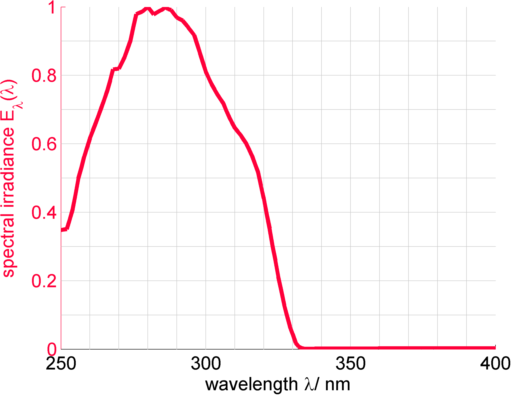

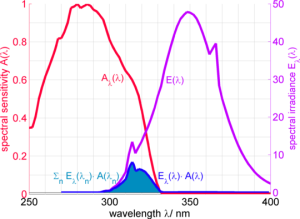
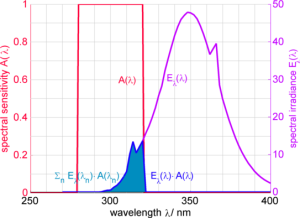
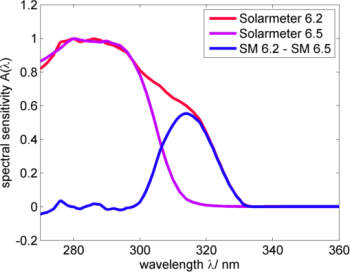
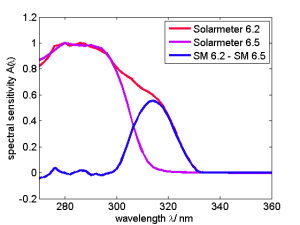
Discussion
Very thorough analysis of Solarmeter 6.2 UVB and 6.5 UVI meters.
Ideally the UVB spectral response graph would be a rectangle rather than a bell curve. But as you show… only a spectralradiometer can provide that.
The UVI spectral response is as close as we can make it to the erythema action spectrum (similar to the D3 action spectrum) on a log-log scale.
Hello Steve, thank you for your comment! Sarina